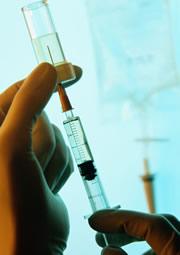 Help or harm? Future tests might better tell when a drug trial will go wrong.Getty
Help or harm? Future tests might better tell when a drug trial will go wrong.GettyImmunologists studying what went wrong in the fateful Northwick Park drug trial in London in March 2006 have developed a test that they say may have spotted the near-deadly effects of the 'superantibody' drug TGN1412.
The announcement came at the unveiling of a report by the expert scientific group convened to provide guidelines to the Medicines and Healthcare Products Regulatory Agency (MHRA), which governs UK clinical trials. The group has provided a list of 22 recommendations to minimize the risk from phase-one clinical trials, during which a new drug is tested on humans for the first time.
Six volunteers became critically ill during the phase-one test of TGN1412, developed by now-defunct drug firm TeGenero. Although preclinical research on monkeys had shown no sign of danger, the drug provoked devastating immune reactions in the human subjects.
“If our test had been available, I would say it should have been used.”
Stephen Inglis, Expert Scientific Group on phase-one clinical trials.
Immunologist Stephen Inglis a researcher at the National Institute for Biological Standards and Control in London and a member of the expert group, has now developed a lab test using human immune cells that shows the same overactivation and proliferation seen in the volunteers. Although still being refined and developed, he hopes that similar tests could become a routine part of preclinical testing of new drugs that target the immune system.
Stuck and dried
The victims of the TGN1412 disaster suffered a 'cytokine storm', featuring massive release of inflammatory molecules called cytokines, and overproliferation of immune cells known as CD4 cells. In Inglis's studies, this effect could only be reproduced when the TGN1412 antibodies were dried onto the surface of an experimental vessel before being presented with human immune cells, rather than floating in solution as in usual preclinical toxicity tests. Antibodies that are dried and stuck to a surface are often more active.
It is not entirely clear why the drug produced such devastating effects in humans but not in macaques, which possess an almost identical receptor protein for the antibody. But using antibody-immobilization tests such as the one developed by Inglis could help to identify potential dangers not flagged up by animal tests.
"If I were developing a drug of this kind in the future, I would take these tests seriously," Inglis said at the unveiling of the expert group's report. "I would hope they become standard in future." He and his colleagues are preparing to publish details of the test in a scientific journal.
Failed tests
Gordon Duff, chair of the group, said that every effort should be made to consult outside experts and search preclinical results to highlight particular dangers of "high-risk" drug candidates. These include drugs that act on the immune system, as well as compounds with new biological activities and those with species-specific effects for which animal tests might not be reliable. This could be done in advance to create a large database, as well as on a case-by-case basis for proposed drug trials.
ADVERTISEMENT
The group also called for the creation of a Europe-wide database of preclinical data, including details of 'failed' animal studies in which drug candidates were found to be toxic. "We need information from abandoned trials," said group member Janet Darbyshire, of the Medical Research Council's Clinical Trials Unit in London. Usually, the MHRA only sees data from preclinical trials that have produced successful results, which are submitted as part of clinical trial applications, she said.
Among the group's other recommendations to the MHRA were that dedicated centres for phase-one drug tests should be set up within existing hospitals, that doses should be staggered between patients and patients monitored carefully, and that initial doses for phase-one trials should be less than the drug's "minimum anticipated biological effect level".
Visit our testcouldweedout_danger.html">newsblog to read and post comments about this story.
